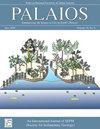美国犹他州东南部不同植物产地沉积物中莫里森组(上侏罗统)一块含无蛇类骨骼的小反流石的意义
IF 1.5
4区 地球科学
Q2 GEOLOGY
引用次数: 2
摘要
摘要:在美国犹他州东南部莫里森组植物区发现的一个新标本显示出一种小型溴石的特征,可能来自鱼类或半水生哺乳动物。该标本由一簇小骨头组成,主要是指无尾两栖动物,包括至少一只小青蛙(可能是蝌蚪)的元素,可能是该地层中最小的蝾螈标本。化学和地形学特征表明,该标本是一种反流石,是莫里森组和北美侏罗纪的第一种。凤梨岩中的无尾虫物质代表了该地层中最南端可能出现的青蛙和蝾螈。可能的蝾螈材料可能代表一个罕见的幼鱼而不是一个新的分类单元,它在形态上更类似于Valdotriton和Comonecturoides,而不是Iridotriton。青蛙的材料同样无法识别特定的分类单元。本文章由计算机程序翻译,如有差异,请以英文原文为准。
SIGNIFICANCE OF A SMALL REGURGITALITE CONTAINING LISSAMPHIBIAN BONES, FROM THE MORRISON FORMATION (UPPER JURASSIC), WITHIN A DIVERSE PLANT LOCALITY DEPOSIT IN SOUTHEASTERN UTAH, USA
Abstract: A new specimen from a plant locality in the Morrison Formation of southeastern Utah exhibits characters suggestive of a small bromalite, possibly from a fish or semi-aquatic mammal. The specimen consists of a cluster of small bones, most referable to lissamphibians, including elements of at least one small frog (possibly a tadpole) and possibly the smallest reported salamander specimen from the formation. Chemical and taphonomic characters suggest that the specimen is a regurgitalite, the first from both the Morrison Formation and the Jurassic of North America. The lissamphibian material in the bromalite represents the southernmost likely occurrence of frogs and salamanders in the formation. The possible salamander material may represent a rare juvenile rather than a new taxon, and it is morphologically more similar to Valdotriton and Comonecturoides than it is to Iridotriton. The frog material is similarly unidentifiable to specific taxon.
求助全文
通过发布文献求助,成功后即可免费获取论文全文。
去求助
来源期刊

Palaios
地学-地质学
CiteScore
2.80
自引率
12.50%
发文量
40
审稿时长
6 months
期刊介绍:
PALAIOS is a monthly journal, founded in 1986, dedicated to emphasizing the impact of life on Earth''s history as recorded in the paleontological and sedimentological records. PALAIOS disseminates information to an international spectrum of geologists and biologists interested in a broad range of topics, including, but not limited to, biogeochemistry, ichnology, paleoclimatology, paleoecology, paleoceanography, sedimentology, stratigraphy, geomicrobiology, paleobiogeochemistry, and astrobiology.
PALAIOS publishes original papers that emphasize using paleontology to answer important geological and biological questions that further our understanding of Earth history. Accordingly, manuscripts whose subject matter and conclusions have broader geologic implications are much more likely to be selected for publication. Given that the purpose of PALAIOS is to generate enthusiasm for paleontology among a broad spectrum of readers, the editors request the following: titles that generate immediate interest; abstracts that emphasize important conclusions; illustrations of professional caliber used in place of words; and lively, yet scholarly, text.
 求助内容:
求助内容: 应助结果提醒方式:
应助结果提醒方式:


